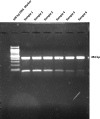Establishing, Expanding, and Certifying a Closed Colony of Phlebotomus argentipes (Diptera: Psychodidae) for Xenodiagnostic Studies at the Kala Azar Medical Research Center, Muzaffarpur, Bihar, India
- PMID: 28525618
- PMCID: PMC5850120
- DOI: 10.1093/jme/tjx099
Establishing, Expanding, and Certifying a Closed Colony of Phlebotomus argentipes (Diptera: Psychodidae) for Xenodiagnostic Studies at the Kala Azar Medical Research Center, Muzaffarpur, Bihar, India
Abstract
This pilot project was preliminary and essential to a larger effort to define the ability of certain human-subject groups across the infection spectrum to serve as reservoirs of Leishmania donovani infection to sand flies in areas of anthroponotic transmission such as in Bihar state, India. This is possible only via xenodiagnosis of well-defined subject groups using live vector sand flies. The objective was to establish at the Kala Azar Medical Research Center (KAMRC), Muzaffarpur, Bihar, India, a self-sustaining colony of Phlebotomus argentipes (Annandale & Brunneti), closed to infusion with wild-caught material and certified safe for human xenodiagnosis. Prior to this endeavor, no laboratory colony of this vector existed in India meeting the stringent biosafety requirements of this human-use study. From March through mid-December, 2015, over 68,000 sand flies were collected in human dwellings and cattle sheds using CDC-type light traps over 254 nights. Blood-fed and gravid P. argentipes females were selected and placed individually in isoline-rearing vials for oviposition, and >2,500 egg clutches were harvested. Progeny were reared according to standard methods, providing a continuous critical mass of F1 males and females to stimulate social feeding behavior. With construction of a large feeding cage and use of a custom-made rabbit restrainer, the desired level of blood-feeding on restrained rabbits was achieved to make the colony self-sustaining and expand it to working level. Once self-sustaining, the colony was closed to infusion with wild-caught material and certified free of specific human pathogens.
Keywords: Phlebotomus argentipes; colonization; sand fly; xenodiagnosis.
© The Authors 2017. Published by Oxford University Press on behalf of Entomological Society of America. All rights reserved. For Permissions, please email: journals.permissions@oup.com.
Figures








References
-
- American Committee of Medical Entomology. 2003. Arthropod Containment Guidelines. Vector-Borne and Zoonotic Diseases, Mary Anne Liebert, Inc. 32: 75–90. (http://online.liebertpub.com/doi/pdf/10.1089/153036603322163475) (accessed 2 May 2017). - DOI
-
- Alkan C., Bichaud L., de Lamballerie X., Alten B., Gould E. A., Charrel R. N.. 2013. Sandfly-borne phleboviruses of Eurasia and Africa: Epidemiology, genetic diversity, geographic range, control measures. Antiviral Res. 100: 54–74. http://dx.doi.org/10.1016/j.antiviral.2013.07.005 (accessed 2 May 2017). - DOI - PubMed
-
- Dinesh D. S., Ranjan A., Palit A., Kishore K., Kar S. K.. 2001. Seasonal and nocturnal landing/biting behaviour of Phlebotomus argentipes (Diptera: Psychodidae). Ann. Trop. Med. Parasitol. 95: 197–202. - PubMed
-
- Ghosh K. N., Ghosh D. K., De A., Battacharya A.. 1991. Biology of Phlebotomus argentipes Annandale and Brunetti and P. papatasi (Scopoli) in the laboratory. Ann. Parasitol. Hum. Comp. 67: 55–61.
-
- Jones T. M., Hamilton J.G.C.. 1998. A role of pheromones in mate choice in a lekking sandfly. Anim. Behav. 56: 891–898. - PubMed
Publication types
MeSH terms
LinkOut - more resources
Full Text Sources
Other Literature Sources

